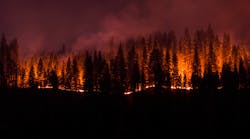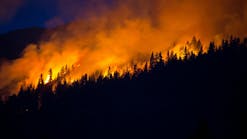CPUC Proposes Enhanced Oversight Process for PG&E Wildfire Mitigation Work, Utility Responds
The California Public Utilities Commission (CPUC) recently issued a proposal that, if approved, would place Pacific Gas and Electric Co. (PG&E) into the first step of an enhanced oversight and enforcement process. The process would be based on the company’s failure to sufficiently prioritize clearing vegetation on its highest-risk power lines as part of its wildfire mitigation work in 2020.
The CPUC’s enhanced oversight and enforcement process for the PG&E has six steps that are triggered by specific findings or events. The process was imposed by the CPUC as a condition of approving the PG&E’s plan for exiting bankruptcy in May 2020 and provides a clear roadmap for how the CPUC closely monitors the utility’s performance in delivering safe, reliable, affordable, and clean energy.
The proposed resolution directs the PG&E to submit to the CPUC a corrective action plan and progress reports every 90 days. The corrective action plan is intended to create a path to help ensure that in 2021 the PG&E is prioritizing its enhanced vegetation management based on wildfire risk throughout its electric system.
In response, the PG&E said in a statement: "We will promptly prepare the corrective action plan to address the issues in the draft resolution, with clear timelines and commitments. We are committed to this critical work, and we welcome continued feedback and oversight from the CPUC and other stakeholders as we continue to learn, adapt, and strengthen our system for the long term."
The recent CPUC action builds on findings in an audit report issued by the Commission’s Wildfire Safety Division into the PG&E’s enhanced vegetation management activities. The Division found that in 2020, the PG&E failed to clear hazardous vegetation from power lines that posed the highest wildfire risks, based on the company’s own risk rankings. Instead, the PG&E logged the majority of its compliance work on lower-risk power lines — the opposite of expectations set out in the company’s Wildfire Mitigation Plan.
In a November 2020 letter, CPUC President Marybel Batjer notified the PG&E of the CPUC’s concerns that the utility may be deficient in its responsibility to safely manage wildfire risks posed by trees and other vegetation. The recently proposed resolution, if adopted, would confirm that the utility failed to make sufficient risk-driven investments in its vegetation management practices.
The PG&E said: "The findings received are consistent with concerns raised in prior reports from the CPUC and our federal monitor about our enhanced vegetation management program. We continue to take this feedback seriously. We have already implemented improvements to this program and will continue to do so."
Certain enhancements that the PG&E said address the issues identified by the CPUC are reflected in the utility’s 2021 Wildfire Mitigation Plan. These include:
- Enhanced wildfire risk model: The PG&E’s new wildfire risk model leverages predictive analysis of environmental conditions that have the potential to turn a small fire into a major wildfire. The utility has implemented machine learning to enable an evolution from static to dynamic risk models. State-of-the-art remote sensing capabilities are being used to obtain an understanding of both the fuel type and conditions that contribute to fire spread in high-fire risk areas.
- A risk-focused approach: The PG&E’s 2020 Wildfire Mitigation Plan was primarily activity-based, focusing on miles of lines completed for its key wildfire safety measures, such as enhanced vegetation management and system hardening. The company’s 2021 plan is risk-focused, identifying the highest-risk areas for mitigation as top priority, as informed by its enhanced predictive wildfire risk models.
- Elevated transparency: The PG&E has recently formed a Wildfire Risk Governance Steering Committee, responsible for approving the selection of enhanced vegetation management work locations and monitoring regular reporting of work completed. This will ensure actual work aligns with planned risk reduction and is performed with the highest level of quality.
Additionally, the PG&E is adding more than 200 work verification inspectors performing post-tree inspections on work executed in high fire-threat districts (HFTDs) for both enhanced and routine vegetation management programs in 2021. It is also implementing the use of ground-based LiDAR with vehicles as post-inspection review of completed circuits for vegetation management work.
"The PG&E shares the CPUC’s focus on safety and recognizes that we must take a leading role in reducing the risk of wildfires throughout our service area. We understand that the most important responsibility that we have as a company and as individuals is to keep our customers, communities, and workforce safe," said the utility in its statement.
CPUC safety staff will closely monitor the PG&E’s corrective actions and ensure that the utility’s risk-driven prioritization is carried out by its vegetation management crews on the ground.
The PG&E has staffed a centralized team of arborists to investigate any concerns or findings raised by the CPUC, federal monitor, operational observer, or any of its external stakeholders to ensure timely follow-up and resolution of identified issues.
If the PG&E demonstrates it is prioritizing high-risk lines for enhanced vegetation management in 2021, the utility could be removed from the enhanced oversight process. If it fails, the CPUC may issue a new resolution to advance the PG&E in the process.


